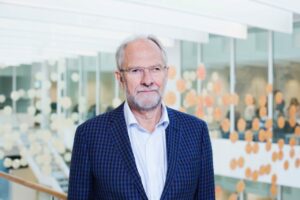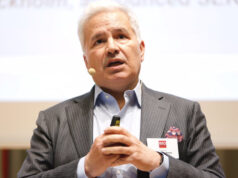
Den innovativa kraften bakom Ultimovacs cancervaccin
Lovande kliniska data förstärker faktumet att Ultimovacs universella cancervaccin UV1 har potential att bli en ny behandlingslinje för cancerpatienter. Bolagets breda kliniska pipeline för utvärdering av kandidaten är kulmen på årtionden av forskning ledd av en av pionjärerna inom cancerimmunterapi, professor Gustav Gaudernack. BioStock kom i kontakt med professor Gaudernack, som för närvarande är CSO på Ultimovacs, för att få veta mer om hans arbete.
Trots stora framsteg inom onkologiområdet under det senaste decenniet är behovet av bättre behandlingar fortfarande extremt högt. Det norska bioteknikbolaget Ultimovacs är ett av de bioteknikbolag som arbetar hårt för att få ut ett nytt cancervaccin till patienterna.
Ett universellt cancervaccin
Bolagets vaccinkandidat UV1 utvärderas just nu i en fas I-studie och fem fas II-studier. Ultimovacs strategi är att kombinera UV1 med andra klasser av immunterapi, som checkpointhämmare (CPI) för att öka patientens immunsvar, vilket gör attacken mot cancern mer robust och långvarig.
Det som gör UV1 till en så lovande kandidat är dess mål: telomeras – ett enzym som är uttryckt i ungefär 90 procent av alla typer av cancer. Cancerceller kan inte mutera bort från telomeras eftersom det är ett essentiellt enzym för tumörens odödlighet och obegränsade kraft att växa. Detta gör UV1 till ett universellt cancervaccin som kan attackera nästan alla typer av cancer. För en mer detaljerad överblick på Ultimovacs teknologi för att bekämpa cancer, se denna BioStock-intervju med bolagets Chief Innovation Officer, Sara Mangsbo.
En pionjär inom cancervaccinteknik
Enligt Allied Market Research beräknas den globala marknaden för cancervacciner nå ett värde om 7 miljarder USD år 2027, från 4 miljarder USD 2019. Området cancervacciner är med andra ord tämligen övertygande, och dess popularitet har ökat de senaste åren. Bevis på detta har visats bara under de senaste månaderna, när experterna inom Covid-19 messenger RNA (mRNA) vacciner Moderna och BioNtech båda delgav sina planer på att utveckla egna cancervacciner. Läs mer om cancervaccin här.
Redan i slutet av 1970-talet och början av 1980-talet började immunterapeuter fundera på möjligheterna med vaccin mot cancer. En av dessa forskare var Gustav Gaudernack. På 90-talet började Gaudernack, som professor och chef för enheten för immunterapi vid Radiumhospitalet i Oslo, att utveckla det som nu är Ultimovacs ledande produkt, UV1.
En djupdykning i Gaudernacks arbete
Sedan dess har professor Gaudernack initierat över 20 kliniska studier inom cancervaccinering, inklusive världens första peptidvaccinstudie inom cancer. Han står bakom fler än 50 patent och 15 licenser för monoklonala antikroppar, cancervacciner och cancerdiagnostik. Ultimovacs grundades år 2011 baserat på Gaudernacks arbete, och han har fortsatt att spela en avgörande roll för bolaget som Chief Scientific Officer.
BioStock kontaktade professor Gaudernack för att få veta mer om hans forskning och nuvarande arbete på Ultimovacs.
Professor Gaudernack, what led you to the idea of a vaccine against cancer?
– As a biology student at the University of Oslo in the early 1960s, I learned that many cancer forms in research animals are due to infection by certain viruses. It was then obvious to me that vaccination against such viruses could potentially have an impact on cancer development, both at the level of prevention and as a novel treatment modality. The problem at that time was that similar viruses were not known to cause common human cancers.
At what stage in your career did you realise that such a vaccine could become a reality?
– It was a stepwise process. It all started in 1973 as a research fellow at the newly established Arctic University in Tromsø, Norway. My project was to vaccinate mice against a tumour called MOPC-315. We made two important observations: 1. antibodies generated against the vaccine were actually hitting their target in the mice; 2. vaccination also generated a T-cell response against the vaccine.
– With the identification of the enzyme telomerase as the immortalising factor in virtually all forms of cancer, a new target, TERT (telomerase reverse transcriptase), emerged as a candidate for a universal cancer vaccine in humans. In collaboration with HYDRO AS, we synthesized and tested a large number of potential candidate peptides to identify the ones that were most frequently recognised by blood samples from a large number of cancer patients. These efforts led to the development of the first-generation telomerase vaccine, GV1001.
– After 10 years of clinical trials with GV1001 in multiple indications, we were able to collect long-term follow-up clinical data and put together a large biobank of blood samples from vaccinated patients. We investigated “epitope spreading” – an interesting immunological phenomenon suggesting that the immune system is able to perform more efficiently. So, we studied whether GV1001 vaccination would result in a novel immune response against other parts of h-TERT, and we were able to show that this was indeed the case. These data resulted in the design of a second-generation vaccine, UV1, and the founding of the start-up company Ultimovacs ASA.

Now, decades later, cancer vaccines are a big presence in the immuno-oncology space. What are your thoughts as you look back at the progress made within the field?
– The field of cancer vaccines has made considerable progress over the last 30 years, mainly due to fundamental changes in the understanding of how the immune system operates and on the technological development. One negative factor, in my opinion, was that the development was for many years side-tracked by what was almost an obsession for development of vaccines based on short peptides designed to generate tumour-specific cytotoxic T-cells. This strategy failed to recognise the role of helper T-cells in orchestrating a stronger, broader and more complete T-cell response. The other factor that stands out is the now recognised role of immune checkpoints – the true clinical potency of cancer vaccines can only be revealed in combination with checkpoint inhibitors (CPIs).
Cancer remains one of the deadliest diseases, causing a heavy burden, not only on patients and their loved ones, but on society as a whole. How much work still needs to be done to find a cure, and are cancer vaccines part of that equation?
– A final cure for all cancer at every stage in life is an uphill fight against evolutionary forces in biology. The task, as I see it, is to find better treatments, i.e., more efficient and with fewer side effect. This is well within the scope of what can be obtained by immunotherapy. The occurrence of a pre-existing spontaneous immune response against a patient’s tumour is the cornerstone of current cancer immunotherapy, on which the mode of action of CPIs rests. These responses are, by their nature, not under a physician’s control.
– Therapeutic cancer vaccines represent a unique and complementary approach to mainstream tumour immunotherapy, i.e., CPIs, aiming to provide a new wave of cancer-specific T-cells in patients with various forms of cancer. Cancer vaccines may thereby supplement and reinforce pre-existing cancer immune responses and pave the way for synergy with any CPI and other cancer drugs designed to improve tumour immunity. Cancer vaccines are thus definitely part of the equation.
Shifting gears, what makes UV1 stand out among other types of cancer immunotherpies being developed?
– UV1 is standing out as a unique vaccine both by virtue of the expression of its target, h-TERT, which is expressed in over 90 per cent of all cancers, and by its history as a second-generation vaccine, building on 10 years of experience and treatment of over 1000 patients with the first-generation vaccine, GV1001. h-TERT is THE immortalising factor giving cancer cells unlimited power to grow. Tumours are notoriously unstable, and a moving target for therapy. h-TERT is present from the earliest stage of tumour development and throughout the life and evolution of a tumour in the patients. No other tumour target matches this property.
Finally, what are your expectations for UV1 and Ultimovacs as the company goes deeper into clinical development?
– I expect to see UV1 used in an increasing number of cancer indications, in combination with the currently used CPIs and with novel CPIs and other drugs that may amplify the generation of UV1 specific T-cells during vaccination and facilitate the function of UV1 specific T-cells within the tumour microenvironment. I expect that UV1 will be used in earlier phases of tumour development such as the neo-adjuvant setting. I also believe that we will later move into the prophylactic setting, starting with patients having a high risk of developing cancer, either by exposure to carcinogens such as asbestos or by genetic disposition, such as variants/mutations in the h-TERT gene or other inherited cancer disposing genes.
Innehållet i BioStocks nyheter och analyser är oberoende men BioStocks verksamhet är i viss mån finansierad av bolag i branschen. Detta inlägg avser ett bolag som BioStock erhållit finansiering från.


